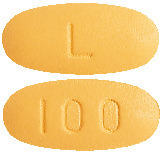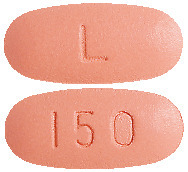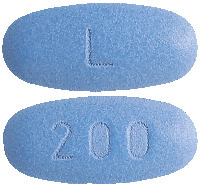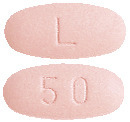SUMMARY CMI
LACOSAMIDE ARX
Consumer Medicine Information (CMI) summary
The full CMI on the next page has more details. If you are worried about using this medicine, speak to your doctor or pharmacist.
1. Why am I using LACOSAMIDE ARX?
LACOSAMIDE ARX contains the active ingredient lacosamide. LACOSAMIDE ARX is used by itself (in patients over 16 years) or in combination with other medicines (in patients over 4 years) to control epilepsy.
For more information, see Section 1. Why am I using LACOSAMIDE ARX? in the full CMI.
2. What should I know before I use LACOSAMIDE ARX?
Do not use if you have ever had an allergic reaction to LACOSAMIDE ARX or any of the ingredients listed at the end of the CMI.
Talk to your doctor if you have any other medical conditions, take any other medicines, or are pregnant or plan to become pregnant or are breastfeeding.
For more information, see Section 2. What should I know before I use LACOSAMIDE ARX? in the full CMI.
3. What if I am taking other medicines?
Some medicines may interfere with LACOSAMIDE ARX and affect how it works.
A list of these medicines is in Section 3. What if I am taking other medicines? in the full CMI.
4. How do I use LACOSAMIDE ARX?
- Swallow LACOSAMIDE ARX tablets whole with a glass of water.
More instructions can be found in Section 4. How do I use LACOSAMIDE ARX? in the full CMI.
5. What should I know while using LACOSAMIDE ARX?
| Things you should do |
|
| Things you should not do |
|
| Driving or using machines |
|
| Drinking alcohol |
|
| Looking after your medicine |
|
For more information, see Section 5. What should I know while using LACOSAMIDE ARX? in the full CMI.
6. Are there any side effects?
LACOSAMIDE ARX helps most people with epilepsy but may have unwanted side effects in a few people. All medicines can have side effects. Sometimes they are serious, most of the time they are not. You may need medical treatment if you get some of the side effects. Common side effects include: dizziness or problems with balance or coordination, headache, nausea, feeling tired, drowsy or sleepy, forgetfulness, tremors or itching.
For more information, including what to do if you have any side effects, see Section 6. Are there any side effects? in the full CMI.
FULL CMI
LACOSAMIDE ARX
Active ingredient(s): lacosamide
Consumer Medicine Information (CMI)
This leaflet provides important information about using LACOSAMIDE ARX. You should also speak to your doctor or pharmacist if you would like further information or if you have any concerns or questions about using LACOSAMIDE ARX.
Where to find information in this leaflet:
1. Why am I using LACOSAMIDE ARX?
2. What should I know before I use LACOSAMIDE ARX?
3. What if I am taking other medicines?
4. How do I use LACOSAMIDE ARX?
5. What should I know while using LACOSAMIDE ARX?
6. Are there any side effects?
7. Product details
1. Why am I using LACOSAMIDE ARX?
LACOSAMIDE ARX contains the active ingredient lacosamide. LACOSAMIDE ARX belongs to a group of medicines called antiepileptics. These medicines are thought to work by controlling brain chemicals which send signals to nerves so that seizures do not happen.
LACOSAMIDE ARX is used to by itself (in patients over 16 years) or in combination with other medicines (in patients over 4 years) to control epilepsy. Epilepsy is a condition where you have repeated seizures. There are many different types of seizures, ranging from mild to severe.
2. What should I know before I use LACOSAMIDE ARX?
Warnings
Do not use LACOSAMIDE ARX if:
- you are allergic to lacosamide, or any of the ingredients listed at the end of this leaflet.
- Always check the ingredients to make sure you can use this medicine.
- you have, or have had, a heart condition causing an uneven heart beat.
Check with your doctor or pharmacist if you:
- have any other medical conditions:
- heart problems
- kidney problems
- liver problems.
- Any mental health condition, such as depression. - take any medicines for any other condition especially barbiturates (such as phenobarbitone) or any other antiepileptic medicines (such as carbamazepine, lamotrigine or levetiracetam)
During treatment, you may be at risk of developing certain side effects. It is important you understand these risks and how to monitor for them. See additional information under Section 6. Are there any side effects?
Pregnancy and breastfeeding
Check with your doctor if you are pregnant or intend to become pregnant.
LACOSAMIDE ARX may affect your developing baby if you take it during pregnancy. However, it is very important to control your seizures while you are pregnant. Your doctor will outline and weigh up all the risks and benefits of taking LACOSAMIDE ARX during pregnancy to help decide whether or not you should take it.
Talk to your doctor if you are breastfeeding or intend to breastfeed.
Your doctor will discuss the risks and benefits of using LACOSAMIDE ARX if you are breastfeeding.
3. What if I am taking other medicines?
Tell your doctor or pharmacist if you are taking any other medicines, including any medicines, vitamins or supplements that you buy without a prescription from your pharmacy, supermarket or health food shop.
Some medicines may interfere with LACOSAMIDE ARX and affect how it works.
- medicines to treat heart problems
- medicine which may have an effect on your heart beat such as carbamazepine, lamotrigine or pregabalin.
LACOSAMIDE ARX does not interact with the oral contraceptive pill.
However, you may be given LACOSAMIDE ARX together with other antiepileptic medicines that do interact and may affect the effectiveness of your contraceptive. Your doctor may advise you to use an additional method of contraception if you take LACOSAMIDE ARX with other antiepileptic medicines.
Check with your doctor or pharmacist if you are not sure about what medicines, vitamins or supplements you are taking and if these affect LACOSAMIDE ARX.
4. How do I use LACOSAMIDE ARX?
How much to take / use
- Your doctor will tell you how much LACOSAMIDE ARX you will need to take each day.
- This may depend on your condition, your body weight, and whether or not you are taking any other medicines.
- Your doctor may start you on a low dose of LACOSAMIDE ARX first of 50 mg twice a day. Your doctor may slowly increase your dose up to a maximum of 300 mg twice a day, until you are taking enough to control your epilepsy and you are not having any seizures.
- Swallow LACOSAMIDE ARX tablets whole with a glass of water.
- Follow the instructions provided and use LACOSAMIDE ARX until your doctor tells you to stop.
When to take / use LACOSAMIDE ARX
- Take LACOSAMIDE ARX twice a day, once in morning and once in night.
Taking your medicine at the same time each day will have the best effect. It will also help you remember when to take it.
It does not matter if you take this medicine before or after food.
If you forget to use LACOSAMIDE ARX
LACOSAMIDE ARX should be used regularly at the same time each day.
Contact your doctor if you have missed one or more doses.
Do not take a double dose to make up for the dose that you missed.
This may increase the chance of you getting an unwanted side effect.
If you use too much LACOSAMIDE ARX
If you think that you have used too much LACOSAMIDE ARX, you may need urgent medical attention.
You should immediately:
- phone the Poisons Information Centre
(by calling 13 11 26), or - contact your doctor, or
- go to the Emergency Department at your nearest hospital.
You should do this even if there are no signs of discomfort or poisoning.
5. What should I know while using LACOSAMIDE ARX?
Things you should do
Call your doctor straight away if you:
- Notice an increase in seizures
- Have symptoms of depression or thoughts of harming yourself.
- Become pregnant while taking this medicine, tell your doctor.
- Before you have any surgery or emergency treatment, tell your doctor or dentist that you are taking LACOSAMIDE ARX.
- Tell your doctor if you feel LACOSAMIDE ARX is not helping your condition.
- For any reason, you have not taken this medicine exactly as prescribed.
Remind any doctor, dentist or pharmacist you visit that you are using LACOSAMIDE ARX.
Things you should not do
- Do not stop using this medicine suddenly.
- Do not give LACOSAMIDE ARX to anyone else, even if their symptoms seem similar to yours or they have the same condition as you.
- Do not take LACOSAMIDE ARX to treat any other complaints unless your doctor tells you to.
Driving or using machines
Be careful before you drive or use any machines or tools until you know how LACOSAMIDE ARX affects you.
As with other antiepileptic medicines LACOSAMIDE ARX may cause dizziness or drowsiness. This is more frequent at the beginning of treatment or after an increase in the dose.
If you are feeling dizzy or drowsy, do not drive a car, operate machinery, or do anything else that could be dangerous.
Do not give LACOSAMIDE ARX to anyone else, even if their symptoms seem similar to yours or they have the same condition as you.
Do not take LACOSAMIDE ARX to treat any other complaints unless your doctor tells you to.
Do not stop taking LACOSAMIDE ARX or change the dosage unless your doctor tells you to. Stopping suddenly may cause unwanted side effects or make your condition worse.
Drinking alcohol
Tell your doctor if you drink alcohol.
As a safety precaution, do not take LACOSAMIDE ARX with alcohol.
Looking after your medicine
- Keep your tablets in the pack until it is time to take them. If you take the tablets out of the pack they will not keep well.
- Keep your tablets in a cool dry place where the temperature stays below 25°C.
Follow the instructions in the carton on how to take care of your medicine properly.
Store it in a cool dry place away from moisture, heat or sunlight; for example, do not store it:
- in the bathroom or near a sink, or
- in the car or on window sills.
Keep it where young children cannot reach it.
Getting rid of any unwanted medicine
If you no longer need to use this medicine or it is out of date, take it to any pharmacy for safe disposal.
Do not use this medicine after the expiry date.
6. Are there any side effects?
All medicines can have side effects. If you do experience any side effects, most of them are minor and temporary. However, some side effects may need medical attention.
See the information below and, if you need to, ask your doctor or pharmacist if you have any further questions about side effects.
Less serious side effects
| Less serious side effects | What to do |
| Speak to your doctor if you have any of these less serious side effects and they worry you. |
Serious side effects
| Serious side effects | What to do |
| Call your doctor straight away, or go straight to the Emergency Department at your nearest hospital if you notice any of these serious side effects. |
Tell your doctor or pharmacist if you notice anything else that may be making you feel unwell.
Other side effects not listed here may occur in some people.
Reporting side effects
After you have received medical advice for any side effects you experience, you can report side effects to the Therapeutic Goods Administration online at www.tga.gov.au/reporting-problems. By reporting side effects, you can help provide more information on the safety of this medicine.
Always make sure you speak to your doctor or pharmacist before you decide to stop taking any of your medicines.
7. Product details
This medicine is only available with a doctor's prescription.
What LACOSAMIDE ARX contains
| Active ingredient (main ingredient) | 50 mg, 100mg, 150 mg or 200 mg of lacosamide |
| Other ingredients (inactive ingredients) |
The following strengths also contain:
|
Do not take this medicine if you are allergic to any of these ingredients.
What LACOSAMIDE ARX looks like
LACOSAMIDE ARX are available in four strengths:
- 50 mg –Pink, oval, coated tablets, debossed “L” on one side and “50” on other side (Aust R 296750).
- 100 mg – Dark yellow, oval, coated tablets, debossed “L” on one side and “100” on other side (Aust R 296752).
- 150 mg –Salmon, oval, coated tablets, debossed “L” on one side and “150” on other side (Aust R 296760).
- 200 mg –Blue, oval, coated tablets, debossed “L” on one side and “200” on other side (Aust R 296758).
Who distributes LACOSAMIDE ARX
Arrotex Pharmaceuticals Pty Ltd
15-17 Chapel Street
Cremorne VIC 3121
This leaflet was prepared in June 2022.
Published by MIMS August 2022






 The relative risk for suicidal thoughts or behaviour was higher in clinical trials for epilepsy than in clinical trials for psychiatric or other conditions, but the absolute risk differences were similar for the epilepsy and psychiatric indications.
The relative risk for suicidal thoughts or behaviour was higher in clinical trials for epilepsy than in clinical trials for psychiatric or other conditions, but the absolute risk differences were similar for the epilepsy and psychiatric indications.
 The use of lacosamide is associated with dose-related increase in the PR interval. Adverse reactions associated with PR interval prolongation (e.g. atrioventricular block, syncope, bradycardia) may occur. In add-on clinical trials in epilepsy patients the incidence rate of reported first degree AV Block is uncommon, 0.7%, 0%, 0.5% and 0% for lacosamide 200 mg, 400 mg, 600 mg or placebo, respectively. No second or higher degree AV Block was seen in lacosamide treated epilepsy patients.
The use of lacosamide is associated with dose-related increase in the PR interval. Adverse reactions associated with PR interval prolongation (e.g. atrioventricular block, syncope, bradycardia) may occur. In add-on clinical trials in epilepsy patients the incidence rate of reported first degree AV Block is uncommon, 0.7%, 0%, 0.5% and 0% for lacosamide 200 mg, 400 mg, 600 mg or placebo, respectively. No second or higher degree AV Block was seen in lacosamide treated epilepsy patients. In addition, the following adverse drug reactions have been identified as being reported in clinical trials.
In addition, the following adverse drug reactions have been identified as being reported in clinical trials.



 During the 24-week treatment period, the proportion of patients with at least a 50% reduction in PGTCS frequency per 28 days from baseline to the treatment period was 68.1% in the lacosamide group compared with 46.3% in the placebo group; the proportion of patients with at least a 75% reduction in PGTCS frequency per 28 days from baseline to the treatment period was 57.1% in the lacosamide group compared to 36.4% in the placebo group.
During the 24-week treatment period, the proportion of patients with at least a 50% reduction in PGTCS frequency per 28 days from baseline to the treatment period was 68.1% in the lacosamide group compared with 46.3% in the placebo group; the proportion of patients with at least a 75% reduction in PGTCS frequency per 28 days from baseline to the treatment period was 57.1% in the lacosamide group compared to 36.4% in the placebo group.

